U of T Law looks to its future by examining its past
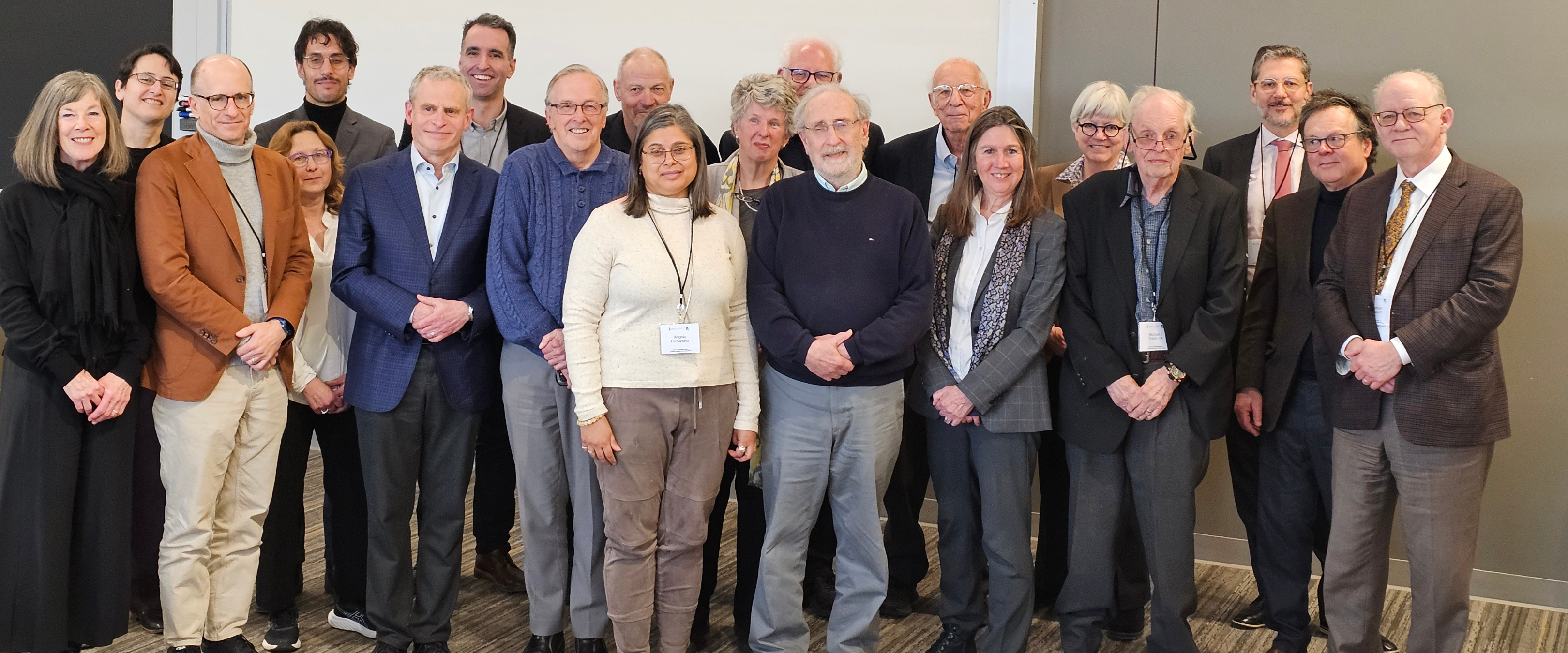
by Nina Haikara, Communications Strategist, Faculty of Law
How have the law and legal education evolved over time? Where do we go from here?
The University of Toronto’s Faculty of Law took pause to reflect during its two-day biennial conference, March 27 and 28.
Law in a Changing World: Looking Forward by Looking Back, brought together present-day faculty members to reflect on pivotal contributions to academic and legal development by U of T Law scholars over the last seven decades.
Their papers will be published in a special volume of the University of Toronto Faculty of Law Journal and in an edited volume published by U of T Press.
“This event marks a rare opportunity for us to revisit the scholarship of our faculty and their contributions to whole range of debates over the years,” says University Professor Jutta Brunnée, dean of the Faculty of Law and James Marshall Tory Dean’s Chair.
Foundations of modern legal education
 Professors Christopher Essert, Mariana Mota Prado (photo left) and Kerry Rittich (photo right) discussed the contributions of “modern legal education” forbearers, Dean Cecil “Caesar” Wright (1949-1965), John Willis (1949-1952 and 1959-1972), who advanced public law scholarship and Bora Laskin (1940-1945 and 1949-1965), 14th Chief Justice of Canada.
Professors Christopher Essert, Mariana Mota Prado (photo left) and Kerry Rittich (photo right) discussed the contributions of “modern legal education” forbearers, Dean Cecil “Caesar” Wright (1949-1965), John Willis (1949-1952 and 1959-1972), who advanced public law scholarship and Bora Laskin (1940-1945 and 1949-1965), 14th Chief Justice of Canada.
“You might have thought that the picture Wright had in his mind was to be more ‘academic’ than ‘practical’, but that’s not the right picture of the matter,” explained Essert of Wright's approach to legal education. “Although there was a part of the university that was dedicated to the academic study of law, it was nothing like what we would now call a law school.”
Wright had in mind, very early on, that what a law school did was ‘teach people to think like a lawyer’, explained Essert. Wright’s task of articulating his vision was challenging, he said, as there was a tendency to regard the law as a set of detailed rules or concepts, something Wright regarded as the ‘slot machine’ conception of legal thinking.
“In the highest sense, we can describe the work of lawyers as the building of a civilization,” said Essert of Wright’s philosophy. “We can’t have anything like a civilization as we know it without law and lawyers.”
Wright's colleague, Bora Laskin, was an outstanding scholar, particularly in the fields of constitutional and labour law. Besides his degrees from U of T and Osgoode Hall Law School, he earned a Master of Laws from Harvard in 1937. He later received an honorary doctorate from Harvard Law in 1979.
“After his time at Harvard, Bora Laskin must have felt simply incredulous at having to defend the need for serious academic training and intellectual inquiry into the law,” said Rittich.
Although Rittich said Laskin's time in the U.S. as a graduate student was relatively short, he became the most significant conduit for the entry of developments in U.S. legal thought, education and practice into the world of Canadian law—developments that occurred over a long span of the 20th century.
“He was uniquely positioned to play this role as conduit because of the powerful and transformative influence he exercised in virtually every position he occupied: Professor. Labour arbitrator. Appellate judge, and, of course, the Chief Justice of Canada,” said Rittich.
“He is one of the most in-exhaustingly compelling figures of Canadian law.”
The next generation
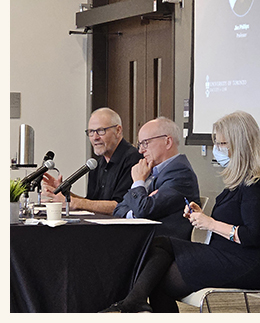 Professors Jim Phillips (photo left), Kent Roach (photo centre) and Associate Dean, Research Brenda Cossman (photo right), highlighted the work of R.C.B. Risk (1962-1998)—a pioneer of Canadian legal history—Martin L. Friedland (1965-1998) and Alan Mewett (1968-2001), as the program continued in the chronological order of scholar's tenure with the faculty.
Professors Jim Phillips (photo left), Kent Roach (photo centre) and Associate Dean, Research Brenda Cossman (photo right), highlighted the work of R.C.B. Risk (1962-1998)—a pioneer of Canadian legal history—Martin L. Friedland (1965-1998) and Alan Mewett (1968-2001), as the program continued in the chronological order of scholar's tenure with the faculty.
“Marty is a person who is first and foremost concerned about injustice,” said Roach of Frieland. “That doesn’t always mean he has a full sense of what a theory of justice is—I certainly don’t—but he has a concern about injustice, and I think that’s a particular calling of an academic lawyer: We have freedom from the profession. We have academic freedom. We should identify and call-out injustice.”
Roach noted Friedland’s 1965 book, Detention Before Trail, is still quoted in Supreme Court of Canada decisions on the right of bail and led to the Bail Reform Act of 1972.
Friedland, a university professor and dean emeritus, was in the audience. He said: “I’m blushing. I’d like to thank everyone for their kind comments. At my age, it’s quite nice to hear them.”
Friedland also acknowledged scholars before him influenced his own work, in particular criminal law reformer Caleb Foote, who taught at the University of Pennsylvania before joining UC Berkeley’s Boalt Hall School of Law. Foote died in 2006 at the age of 88.
Cossman said Mewett was one of Canada’s most distinguished legal scholars in criminal law and evidence and his iconic status extends well beyond academia, as it influenced judicial reasoning, legal education and public policy.
“His writings…around sexual morality and the criminal law were quite remarkable for their radicality and foresightedness and can continue to help us think about how we regulate sex, sexuality and sexual offenses today… A lot of what he argued in favour of, remains uncompleted today,” she said.
Cossman also quoted Mewett’s 2001 obituary: “He was a legendary law teacher whose erudition, laconic humour, and occasional acerbic criticisms made his classes compelling for generations of law students at Saskatchewan, Queens, Osgoode Hall, and, since 1968, the University of Toronto.”
Today, the Alan Mewett Award for Excellence in Teaching is awarded annually to a faculty professor who exhibits excellence in teaching, as selected by the graduating class.
Building intellectual legacies
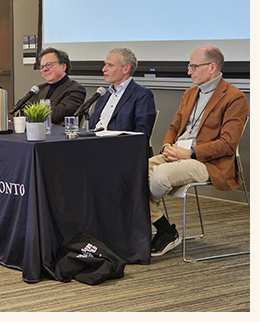 Professors Peter Benson (photo left) Arthur Ripstein (photo centre) and Edward Iacobucci (photo right) shared their perspectives on the late Stephen M. Waddams (1968-2023)—warmly remembered not only for his scholarly contributions but his role as a mentor to many faculty—Earnest J. Weinrib (1972-2021) and Michael J. Trebilcock (1972-2021), after whom the law and economics program is named.
Professors Peter Benson (photo left) Arthur Ripstein (photo centre) and Edward Iacobucci (photo right) shared their perspectives on the late Stephen M. Waddams (1968-2023)—warmly remembered not only for his scholarly contributions but his role as a mentor to many faculty—Earnest J. Weinrib (1972-2021) and Michael J. Trebilcock (1972-2021), after whom the law and economics program is named.
Benson called Waddams’ scholarship “monumental” stating, “It built an edifice of understanding that will last—it’s a rare achievement.”
Ripstein also shared a personal anecdote: “Having Ernie next door [office] was like having Mozart in the studio. The intellectual thrill was incredible. A half-baked idea would turn into hours of exploration.”
Iacobucci spoke on Trebilcock’s legacy, focusing on trade-offs in law and economics. Trebilcock’s 1976 paper, "The Doctrine of Inequality of Bargaining Power: Post-Benthamite Economics in the House of Lords," helped establish him as a foundational figure in law and economics.
Trebilcock, a university professor emeritus who later spoke at the closing roundtable, said: “I am eternally thankful what we that we are a diverse faculty with very diverse perspectives and we and we respect each other. I’m absolutely delighted that I have lots of outstanding colleagues that work in different perspectives from me and I’ve learned a lot from them.”
Also in the audience, Professor Emeritus Weinrib added his legal career was blessed by multiple factors, including his wonderful colleagues and the opportunity to be part of building a law school that stood amongst the best in the world. He also joked: “When I was hired [as a law professor] I had absolutely no preconceptions about what the job was.”
Bridges to the bench
Professors Hamish Stewart, Jean-Christophe Bédard-Rubin and Angela Fernandez spoke to the impact of the Hon. Justice Robert J. Sharpe (1976-1988)—who later held an appointment as Dean from (1990-1995)—the Hon. Justice Katherine E. Swinton (1979-1995)—who had an illustrious 15 year career teaching constitutional law and labour law prior to her appointment to the bench—and Densie Réaume’s (1982-2021) feminist legal scholarship, particularly her work with the Women’s Court of Canada.
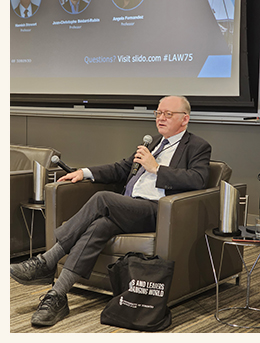 For his paper, Stewart (photo right) examined Sharpe’s The Law of Habeas Corpus published in 1976.
For his paper, Stewart (photo right) examined Sharpe’s The Law of Habeas Corpus published in 1976.
“Now, this may seem rude for me to say this,” said Stewart. “But I feel emboldened to say it because when I told Bob that I’d chosen this book to write about for this symposium he said, ‘Well, isn’t it a little dry?’”
“I was quite startled when on page 97, note five, I found the word ‘intolerable’. .…where does this word intolerable come from in a book that is supposed to be stating the law as it is in a precise, clear, relatively dry format?
“Although [Sharpe] doesn’t quite put it this way himself, I think the book is really about the role of the writ, and therefore, the role of courts, and the role of judges, in a system of law that is oriented towards human freedom,” noted Stewart. "One of the most basic freedoms is the freedom to move about and not be detained and the writ of habeas corpus is an important element in the protection of that right."
The rise of women faculty in the 1980s
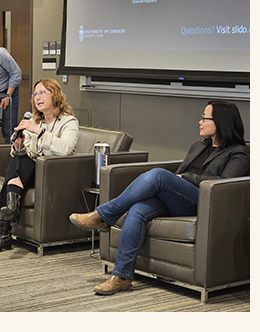 The 1980s saw the appointment of many more women faculty: Carol Rogerson (1983-2021) and Rebecca J. Cook (1987-2012) and Lorraine E. Weinrib (1988-2021).
The 1980s saw the appointment of many more women faculty: Carol Rogerson (1983-2021) and Rebecca J. Cook (1987-2012) and Lorraine E. Weinrib (1988-2021).
Professor Martha Shaffer (photo left) discussed Rogerson’s co-authorship of the Spousal Support Advisory Guidelines, which revolutionized family law across Canada. “Even though the guidelines are advisory, they’ve been cited in more than 5,000 trial judgments and 425 appellate decisions.”
Professor Anna Su (photo right) spoke of Cook's legacy as founder of the International Human Rights Program which has made a profound impact on the lives and careers of countless students since 1987 and that it remains the only human rights clinic of its kind in Canada.
“I’m happy to participate in this event not only because it’s a celebration of what this law school has become but it’s also an opportunity for me to publicly honour the work of Rebecca Cook who’s one of the biggest figures in international human rights law, advocacy and scholarship particularly in the area women’s rights but certainly not just,” said Su.
Cook continues to be active in her research today, leading the International Reproductive and Sexual Health Law Program with the law school.
Professor Richard Stacey spoke to Lorraine E. Weinrib’s impact in constitutional law, particularly Section 33—also known as the notwithstanding clause—of the Canadian Charter of Rights and Freedoms. Weinrib was also in the audience and said it gave her pause to think about how a professor changed her life.
For her, it was R.C.B. "Dick" Risk, whose work in legal history Professor Jim Phillips addressed on the first day of the conference. She wrote a paper on the correspondence between the colonial office in charge of Canadian Aboriginal interests before confederation.
“Dick gave me an ‘A’. There was never any discussion. But the significance of that paper meant I didn’t carry out my intention of quitting law school,” she said, recalling how much she enjoyed writing her legal paper as a self-described "disenchanted classist".
“I feel much better about my law school education today, and so I thank the organizers for having provided me this opportunity to revisit this history,” she said.
Looking ahead
Also in the audience, Professor Emeritus Alan Brudner (1984-2012), thanked Professor Vincent Chiao for the remarks on his research, emphasizing the collegiality of the conference’s core theme.
“Vincent and I come to criminal law from completely different perspectives,” said Brudner. “I see criminal law as comprehensible, essentially the justification of punishment. He thinks criminal law is explicable without any reference to punishment, that it’s part of an administrative state. So, it’s such a tribute—coming from such a different perspective—Vincent can give such a generous and faithful account of my own work.”
In closing, Dean Brunnée reflected on the decision to include a roundtable on the ‘here and now.’
“As we approached the conference, we realized we needed to complement our historical lens and provide an opportunity to discuss the manifold and growing pressures on legal orders and the rule of law we observe right now, within states and internationally—to consider these challenges and their implications and to begin thinking about the future, together.”